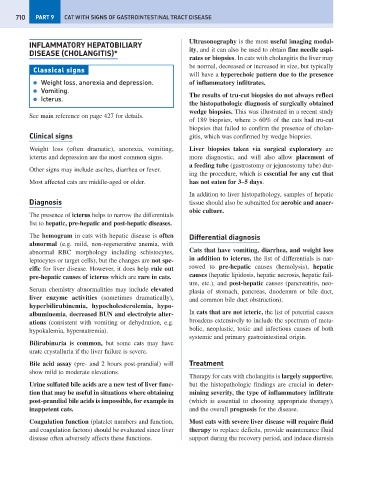Page 718 - Problem-Based Feline Medicine
P. 718
710 PART 9 CAT WITH SIGNS OF GASTROINTESTINAL TRACT DISEASE
Ultrasonography is the most useful imaging modal-
INFLAMMATORY HEPATOBILIARY
DISEASE (CHOLANGITIS)* ity, and it can also be used to obtain fine needle aspi-
rates or biopsies. In cats with cholangitis the liver may
be normal, decreased or increased in size, but typically
Classical signs
will have a hyperechoic pattern due to the presence
● Weight loss, anorexia and depression. of inflammatory infiltrates.
● Vomiting.
The results of tru-cut biopsies do not always reflect
● Icterus.
the histopathologic diagnosis of surgically obtained
wedge biopsies. This was illustrated in a recent study
See main reference on page 427 for details.
of 189 biopsies, where > 60% of the cats had tru-cut
biopsies that failed to confirm the presence of cholan-
Clinical signs gitis, which was confirmed by wedge biopsies.
Weight loss (often dramatic), anorexia, vomiting, Liver biopsies taken via surgical exploratory are
icterus and depression are the most common signs. more diagnostic, and will also allow placement of
a feeding tube (gastrostomy or jejunostomy tube) dur-
Other signs may include ascites, diarrhea or fever.
ing the procedure, which is essential for any cat that
Most affected cats are middle-aged or older. has not eaten for 3–5 days.
In addition to liver histopathology, samples of hepatic
Diagnosis tissue should also be submitted for aerobic and anaer-
obic culture.
The presence of icterus helps to narrow the differentials
list to hepatic, pre-hepatic and post-hepatic diseases.
The hemogram in cats with hepatic disease is often Differential diagnosis
abnormal (e.g. mild, non-regenerative anemia, with
abnormal RBC morphology including schistocytes, Cats that have vomiting, diarrhea, and weight loss
leptocytes or target cells), but the changes are not spe- in addition to icterus, the list of differentials is nar-
cific for liver disease. However, it does help rule out rowed to pre-hepatic causes (hemolysis), hepatic
pre-hepatic causes of icterus which are rare in cats. causes (hepatic lipidosis, hepatic necrosis, hepatic fail-
ure, etc.), and post-hepatic causes (pancreatitis, neo-
Serum chemistry abnormalities may include elevated plasia of stomach, pancreas, duodenum or bile duct,
liver enzyme activities (sometimes dramatically), and common bile duct obstruction).
hyperbilirubinemia, hypocholesterolemia, hypo-
albuminemia, decreased BUN and electrolyte alter- In cats that are not icteric, the list of potential causes
ations (consistent with vomiting or dehydration, e.g. broadens extensively to include the spectrum of meta-
hypokalemia, hypernatremia). bolic, neoplastic, toxic and infectious causes of both
systemic and primary gastrointestinal origin.
Bilirubinuria is common, but some cats may have
urate crystalluria if the liver failure is severe.
Bile acid assay (pre- and 2 hours post-prandial) will Treatment
show mild to moderate elevations.
Therapy for cats with cholangitis is largely supportive,
Urine sulfated bile acids are a new test of liver func- but the histopathologic findings are crucial in deter-
tion that may be useful in situations where obtaining mining severity, the type of inflammatory infiltrate
post-prandial bile acids is impossible, for example in (which is essential to choosing appropriate therapy),
inappetent cats. and the overall prognosis for the disease.
Coagulation function (platelet numbers and function, Most cats with severe liver disease will require fluid
and coagulation factors) should be evaluated since liver therapy to replace deficits, provide maintenance fluid
disease often adversely affects these functions. support during the recovery period, and induce diuresis

